角膜上皮干细胞的功能定位及其与眼表疾病的关系
眼表疾病

查证据
3. 眼表面上皮细胞的损害 4. 泪液的渗透压增高
治疗
1. 2.
水样液缺乏性干眼症 蒸发过强型
1.
水样液缺乏性干眼症
⑴ 消除诱因,治疗原发病
⑵ 补充泪液:人工泪液
1%甲基纤维素、稀释的Healon
自家血清、Gel Tear等
⑶
减少泪液流失
① 减少蒸发 戴硅胶眼罩 湿房镜 潜水镜 亲水性角膜接触镜 ② 泪点封闭 a. 暂时性:泪点栓子或硅胶塞 b. 永久性:泪点封闭术 (烧灼、 手术切除
⑷
促进泪液分泌
用于泪腺组织尚有部分功能者 新斯的明15mg tid
⑸
手术治疗
自体游离颌下腺移植有一定价值 睑裂缝合术、人工角膜等
膜不稳定。 方法:1%荧光素钠滴入结膜囊,瞬目
2~3次,裂隙灯蓝光下检查。令患者向前注视, 不瞬目,观察角膜表面绿色泪液膜破裂所需时 间。表现为“海洋”面上出现黑色小岛。BUT 指最后一次瞬目到干燥斑出现之间的时间。
3.
角膜荧光素染色
观察角膜上皮缺损和判断泪河
高度。荧光素能使泪膜染色
4.
泪液
量7±2µ l/只眼 清蛋白 60% 球蛋白 20% IgA IgG IgE 溶菌酶 K+,Na+, CL少量葡萄糖及尿素
分类:1995年美国干眼研究组
泪液生成不足型
水样液缺乏性干眼症
sjó gren综合征所致干眼症
不伴sjó gren综合征的干眼症
蒸发过强型干眼症
睑板功能障碍、暴
眼科学填空+名词解释+简答题

眼科学填空+名词解释+简答题1、视觉器官包括:眼球、眼眶及眼的附属器、视路、眼部的相关血管和神经结构2、正常眼球前后径出生时16cm,3岁时23cm,成年时24cm 。
眼球向前方平视一般突出外侧眶缘12-14cm,两眼球突出度相差不超过2mm。
23.5mm水平径23.5mm,垂直径为23mm3、眼球由眼球壁、眼球内容物组成。
眼球壁分3成,外层为纤维膜,中层为葡萄膜,内层为视网膜。
外层包括角膜、巩膜、角膜缘、前房角。
角膜组织学上从前向后分为:上皮细胞层、前弹力层、基质层、后弹力层、内皮细胞层。
前房角是房水排出眼球的主要通道。
中层由前到后为虹膜、睫状体、脉络膜。
4、瞳孔括约肌受副交感神经支配,司缩瞳作用;瞳孔开大肌受交感神经支配,司散瞳作用。
睫状肌是平滑肌,受副交感神经支配。
5、视网膜神经感觉层由外向内为:①视锥、视杆层②外界膜③外核层④外丛状层⑤内核层⑥内核状层⑦神经节细胞层⑧神经纤维层⑨内界膜6、眼球内容物包括:房水、晶状体、玻璃体(它们与角膜一并称为眼的屈光介质)7、视神经管管中有视神经、眼动脉、交感神经纤维通过;眶上裂有第三、四、六颅神经、第五颅神经的第一支(眼支)、眼上静脉、部分交感神经纤维通过8、眼睑由外向内分为5层:皮肤层、皮下组织层、肌层、睑板层、结膜层。
9、眼轮匝肌由面神经支配,司眼睑闭合;提上睑肌由动眼神经支配,开启眼睑;Muller肌受交感神经支配。
10、结膜分为睑结膜、球结膜、穹窿结膜。
11、泪器包括泪腺、泪道。
泪道包括泪点、泪小管、泪囊、鼻泪管,为泪液排泄系统。
12、眼外肌分为上直肌、下直肌、內直肌、外直肌,上斜肌、下斜肌13、视神经按其部位分眼内段、眶内段、管内段、颅内段。
14、眼球的血液来自眼动脉,分为视网膜中央血管系统和睫状体血管系统。
睫状血管包括:睫状后短动脉、睫状后长动脉、睫状前动脉15、泪膜分3层:表面脂质层,由睑板腺分泌而成;中间水液层,由泪腺和副泪腺分泌形成;底部黏蛋白层,由眼表上皮细胞及结膜杯状细胞分泌形成16、脉络膜由睫状后短动脉供血17、视信息在视网膜内形成视觉神经冲动,以三级神经元传递,即光感受器——双极细胞——神经节细胞。
眼病学课件 05眼表疾病

二、眼表疾病
ocular surface disease, OSD
眼表疾病的概念
狭义:仅指角、结 膜上皮的疾病
广义:包括角结膜 浅层疾病和可导致 泪膜功能异常的疾 病,或称为“眼表 泪液疾病”
眼表疾病的类型
角、结膜上皮病变 角结膜上皮的角化和鳞状上皮化生 角膜缘干细胞缺乏
损伤造成的 基质微环境异常导致的
生物生长。 4. 提供角膜所需的营养物质。
眼Hale Waihona Puke 上皮与泪膜的关系眼表上皮被稳定的泪膜保护;眼表上皮 参与稳定泪膜的形成
严重的泪膜不稳定可引起角、结膜上皮 的角化和鳞状上皮化生;眼表上皮的病 变可引起泪膜的异常——干眼症
眼表上皮层和泪膜任何一方的异常改变, 都将引起角结膜上皮或泪膜的病变,即 发生眼表疾病
结膜上皮
来源于结膜干细胞 (可能位于结膜穹窿 部或睑缘的皮肤黏膜 结合处)
干细胞(stem cells,SC) 是寿命长且具有强大的细胞分裂潜力的细胞, 自行繁衍引起细胞和组织的更新。
泪膜
tear film
泪膜是通过眼睑的 瞬目运动,将泪液 涂布在眼表形成的 7~10微米厚的超薄 层。从外向内分别 是:
(四)诊 断
尚无统一标准 依据:A 症状
B 泪液分泌不足和泪膜不稳定 C 眼表上皮细胞的损害 D 泪液的渗透压增高
检查方法
泪液分泌试验
– 正常值:10~15mm – 小于10mm为低分泌,小于5mm为干眼 – 测试主、副泪腺的分泌功能
泪膜破裂时间(BUT)
– 小于10秒为泪膜不稳定
荧光素染色
– 阳性代表角膜上皮缺损
干眼症
LASIK术后1个月 角膜弥漫细点状染色
角膜瓣区域为主
干细胞在眼科领域中的应用与研究

干细胞在眼科领域中的应用与研究近年来,干细胞技术的发展为医学领域带来了巨大的希望和可能性。
干细胞具有自我复制和分化为多种类型细胞的潜能,可以用于再生组织和器官。
在眼科领域中,干细胞的应用已经取得了一定的突破,并展现出了广阔的应用前景。
本文将介绍干细胞在眼科领域中的应用及其相关研究。
首先,干细胞在眼表疾病的治疗中发挥着重要的作用。
干细胞可以分化为结缔组织细胞和上皮细胞,这些细胞有助于修复和再生受损的眼表组织。
例如,干细胞可以用于治疗干眼症,这是一种眼表疾病,由于泪液分泌不足或质量下降导致眼表组织受损。
干细胞移植可以促进眼表组织的再生,增加泪液分泌,改善患者的症状。
此外,干细胞还可以用于治疗角膜溃疡、球结膜炎等眼表疾病。
其次,干细胞在角膜疾病的治疗中也有着重要的应用价值。
角膜是眼睛的透明层,常常受到外界伤害和疾病的侵袭。
当角膜受损时,干细胞可以分化为角膜细胞,帮助修复受损的角膜组织。
例如,干细胞移植可以用于治疗角膜炎、角膜溃疡、角膜瘢痕等疾病。
通过将干细胞注入患者的受损角膜区域,可以促进角膜组织的再生,恢复视力和视觉质量。
这种治疗方法已经在实际临床中得到了广泛应用,并取得了显著的疗效。
除了眼表疾病和角膜疾病的治疗,干细胞还可以在视网膜疾病的研究和治疗中发挥重要的作用。
视网膜是眼睛中感光细胞的组织,与人眼的视力密切相关。
一些视网膜疾病,如老年性黄斑变性和视网膜色素变性,会导致视网膜细胞的死亡和视力损失。
干细胞可以分化为视网膜细胞,替代受损的细胞,恢复视网膜的功能。
目前,研究人员正在探索利用干细胞治疗视网膜疾病的方法,并取得了一些初步的进展。
然而,由于视网膜的复杂结构和功能,该领域的研究仍面临许多挑战,需要进一步的研究和探索。
此外,干细胞还可以用于治疗其他眼部疾病,如青光眼、眼部外伤等。
干细胞在这些疾病中的应用虽然尚处于研究阶段,但已经展示出了巨大的潜力。
通过干细胞的再生和分化,可以修复受损的眼部组织,改善患者的症状和生活质量。
角膜缘干细胞及相关疾病治疗
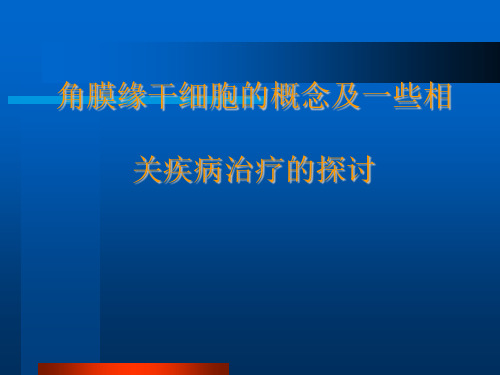
1971年Davanger 角膜缘是角膜上皮细胞移行的根源
1983年Thoft
角膜上皮完整性的“XYZ理论”
结果
角膜周边部上皮细胞增生最为活跃,角 膜缘细胞干细胞
现阶段研究
1986年Schermer 角膜缘基底细胞缺乏特异性 分化蛋白K3
角膜缘干细胞的意义
干细胞是存在于生物体内的少 数未分化细胞,其作用是保持生 物组织的高度再生能力
角膜缘干细胞的特征
无限自我更新能力,分化度低, 有丝分裂度低,非对称核酸分裂 潜能,不可逆分化和应急增殖
临床意义
对角膜上皮的完整性至关重要
正 常 情 况 上皮屏障作用,能阻止结膜 上皮及血管向角膜内生长
结果
损伤区周围的上皮细胞可通过有丝 分裂产生新的上皮细胞,上皮细胞可经 过移行运动覆盖缺损区,即上皮组织包 括角膜上皮细胞具有再生性且能够移动
角膜缘干细胞概念的提出
1944年Ida Mann 角膜缘干细胞的存在
1948年Maumenee 角膜上皮细胞的向心性运动
1961年Hanna 角膜上皮细胞分裂指数 周边>中央
谢
谢
1989年Cotsarelis 角膜缘基底细胞存在慢周 期细胞
1991年Wiley等 角膜缘干细胞(K3阴性)拓 扑分布图
1993年Zeiske
角膜缘基底细胞存在 4G10.3蛋白
结果
证实角膜缘干细胞的存在和位置,但 是到目前为止,证实角膜缘干细胞存在的 依据是间接的,未发现角膜缘干细胞的直 接分子标志
干细胞衰竭 角膜上皮结膜化、血管化、 慢性炎症、复发性上皮糜烂、 瘢痕及假性胬肉形成
与干细胞相关疾病治疗的新思路
不仅要补充足够的干细胞, 还要改善干细胞生存的环境, 二者同等重要。
眼表疾病

防腐剂与干眼
抑制微生物生长、 抑制微生物生长、繁殖的附加剂称为抑菌剂 或防腐剂 含防腐剂细菌检出率12% 含防腐剂细菌检出率12% 12 检出率64% 检出率64% 64 所有防腐剂都可以诱发干眼 防腐剂能损伤角结膜上皮 不含防腐剂细菌
透明质酸钠——治疗医源性干眼 透明质酸钠——治疗医源性干眼
(一)LASIK术后干眼 LASIK术后干眼 眼干是LASIK术后较常见主诉(48% 眼干是LASIK术后较常见主诉(48%),可持续术 后半年至一年( 后半年至一年(Hovanesian 2000,1731例LASIK术后问卷调查) 2000,1731例LASIK术后问卷调查) 表现 角膜知觉降低,瞬目减少,泪分泌量下降 角膜知觉降低,瞬目减少, 表层神经被切断,局麻药,术后局部用药, 表层神经被切断,局麻药,术后局部用药,术后 眼表轻度炎症反应 术后点用0 术后点用0.1%透明质酸钠,稳定泪膜,改善症状 透明质酸钠,稳定泪膜,
干眼症
角结膜干燥症是指任何原因引起 的泪液质和量异常或动力学异常、 导致泪膜稳定性下降,并伴有眼 部不适,引起眼表病变为特征的 多种病症的总称。
病因分类:
1、水样液缺乏性干眼症; 2、粘蛋白缺乏性干眼症; 3、脂质缺乏性干眼症; 4、泪液流体动力学异常所致干眼症。
临床分类:
1、泪液生成不足型; 2、蒸发过强型。
润湿30min以上 润湿30min以上 30min
四代: 70年代) 1.5~ 四代:(70年代)拟粘蛋白聚合物 聚丙烯胺 1.5~6h 年代
临床常用泪液
爱尔康) 泪 然 怡 然(爱尔康) 羟丙基甲基纤维素 含防腐剂
潇莱威(眼力健)羟甲基纤维素 不含防腐剂 眼力健) 眼力健) 利奎芬(眼力健)聚乙烯醇 含防腐剂 爱 丽 (参 天) 透明质酸钠 含/不含防腐剂 福瑞达) 润 舒 (福瑞达) 透明质酸钠 氯霉素
眼科学PPT课件 眼表疾病

11
1
眼干涩和异物感
2
烧灼感、痒感、畏光、红痛
3
视物模糊 视疲劳、粘丝状分泌物等
4
可伴有口干、关节痛
郑大一附院眼科
12
第三节 干眼症
[诊断方法] 泪液分泌试验
正常为10-15mm,<10mm为低分泌,<5mm 为干眼 泪膜破裂时间 <10s为泪膜不稳定
郑大一附院眼科
13
第三节 干眼症
[诊断方法] 泪液蕨类试验
泪液的功能
填补上皮间的不规则界面,保证角膜的光滑
湿润及保护角膜及结膜上皮
通过机械冲刷及内含的抗菌成分抑制微生物生 长
提供角膜所需的营养郑大物一附质院眼科
10
第三节 干眼症
[临床分类] 泪液生成不足型 由于泪腺疾病或功能不良引起的干眼。 泪液蒸发过强型 是泪液分泌正常而蒸发过强引起的干眼。
郑大一附院眼科
3
第一节 概述
二、眼表与干细胞 角膜干细胞 ➢ 角膜上皮来源于位于角膜缘的干细胞,可以迅
速进行自我更新 ➢ 干细胞存在于角膜缘基底细胞层中 ➢ 角膜缘上、下两个部位干细胞较多 ➢ 角膜缘干细胞是分开角膜和结膜的独特结构
郑大一附院眼科
4
第一节 概述
二、眼表与干细胞 结膜干细胞 ➢ 结膜干细胞可能位于结膜穹隆部或睑缘的皮肤
黏膜结合处,是结膜上皮的来源 ➢ 也有研究认为结膜干细胞均匀地分布于眼表结
膜组织 ➢ 角膜缘干细胞遭到破坏后,结膜上皮将越过角
膜缘,覆盖角膜表面,并伴有新生血管和纤维 细胞的侵入
郑大一附院眼科
5
第一节 概述
三、眼表与泪膜 ➢ 眼球表面所覆盖的一层泪膜对维持清新视觉十分重要 ➢ 泪膜厚约7~10微米,从外向内分别由脂质层、水样层
五官科系列-334专业知识-眼表疾病

五官科系列-334专业知识-眼表疾病[单选题]1.有关功能性泪溢,错误的是()。
A.多见于青少年B.冲洗泪道通畅C.与眼轮匝肌松弛有关D.患者泪液泵作用减弱或消失E.部分患者(江南博哥)硫酸锌及肾上腺素溶液滴眼有效正确答案:A参考解析:没有试题分析[单选题]2.属于眼表疾病的是()。
A.慢性泪囊炎B.霰粒肿C.白内障D.Stevens-Johnson综合征E.上睑下垂正确答案:D参考解析:Stevens-Johnson综合征引起泪液缺乏,造成干眼。
因此属于眼表疾病。
[单选题]3.泪膜的脂质层由何分泌而来?()A.主泪腺B.睑板腺C.副泪腺D.结膜杯状细胞E.Zeis腺正确答案:B参考解析:泪膜的脂质层由睑板腺分泌而来。
[单选题]4.关于泪膜的结构,正确的是()。
A.从内向外依次为脂质层、水液层、黏液层B.从内向外依次为水液层、脂质层、黏液层C.从内向外依次为黏液层、水液层、脂质层D.从内向外依次为脂质层、黏液层、水液层E.从内向外依次为水液层、黏液层、脂质层正确答案:C参考解析:关于泪膜的结构,正确的是从内向外依次为黏液层、水液层、脂质层。
[单选题]5.角化上皮细胞增多可见于()。
A.包涵体性结膜炎B.沙眼C.变态反应性结膜炎D.干眼病E.细菌感染性结膜炎正确答案:D参考解析:干眼病可出现角化上皮细胞增多。
[单选题]6.干眼症按病因分类,不包括()。
A.水样液缺乏性干眼症B.脂质缺乏性干眼症C.过敏性干眼症D.黏蛋白缺乏性干眼症E.泪液动力学异常所致干眼症正确答案:C参考解析:干眼症按病因分类,包括水样液缺乏性干眼症、脂质缺乏性干眼症、黏蛋白缺乏性干眼症、泪液动力学异常所致干眼症。
[单选题]7.对于干眼症的诊断没有帮助的是()。
A.泪液分泌试验B.泪膜破裂时间C.泪液渗透压测定D.泪道冲洗E.角膜荧光素染色正确答案:D参考解析:泪道冲洗无助于干眼症的诊断,仅能判断泪道是否通畅。
[单选题]8.下列不属于眼表疾病的是()。
干细胞移植在角膜疾病治疗中的应用策略
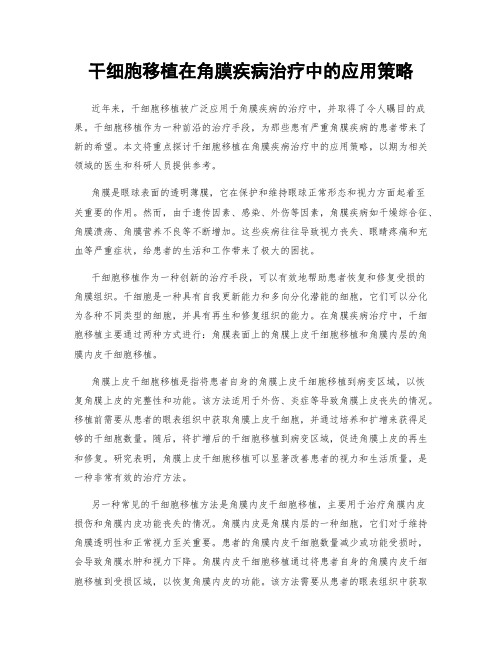
干细胞移植在角膜疾病治疗中的应用策略近年来,干细胞移植被广泛应用于角膜疾病的治疗中,并取得了令人瞩目的成果。
干细胞移植作为一种前沿的治疗手段,为那些患有严重角膜疾病的患者带来了新的希望。
本文将重点探讨干细胞移植在角膜疾病治疗中的应用策略,以期为相关领域的医生和科研人员提供参考。
角膜是眼球表面的透明薄膜,它在保护和维持眼球正常形态和视力方面起着至关重要的作用。
然而,由于遗传因素、感染、外伤等因素,角膜疾病如干燥综合征、角膜溃疡、角膜营养不良等不断增加。
这些疾病往往导致视力丧失、眼睛疼痛和充血等严重症状,给患者的生活和工作带来了极大的困扰。
干细胞移植作为一种创新的治疗手段,可以有效地帮助患者恢复和修复受损的角膜组织。
干细胞是一种具有自我更新能力和多向分化潜能的细胞,它们可以分化为各种不同类型的细胞,并具有再生和修复组织的能力。
在角膜疾病治疗中,干细胞移植主要通过两种方式进行:角膜表面上的角膜上皮干细胞移植和角膜内层的角膜内皮干细胞移植。
角膜上皮干细胞移植是指将患者自身的角膜上皮干细胞移植到病变区域,以恢复角膜上皮的完整性和功能。
该方法适用于外伤、炎症等导致角膜上皮丧失的情况。
移植前需要从患者的眼表组织中获取角膜上皮干细胞,并通过培养和扩增来获得足够的干细胞数量。
随后,将扩增后的干细胞移植到病变区域,促进角膜上皮的再生和修复。
研究表明,角膜上皮干细胞移植可以显著改善患者的视力和生活质量,是一种非常有效的治疗方法。
另一种常见的干细胞移植方法是角膜内皮干细胞移植,主要用于治疗角膜内皮损伤和角膜内皮功能丧失的情况。
角膜内皮是角膜内层的一种细胞,它们对于维持角膜透明性和正常视力至关重要。
患者的角膜内皮干细胞数量减少或功能受损时,会导致角膜水肿和视力下降。
角膜内皮干细胞移植通过将患者自身的角膜内皮干细胞移植到受损区域,以恢复角膜内皮的功能。
该方法需要从患者的眼表组织中获取干细胞,并经过培养和扩增。
随后,将获得的干细胞移植到受损的角膜内层,促进角膜内皮的再生和修复。
眼科疾病 眼表疾病 眼表概述 眼科学课件

2
泪液动力学
➢ 泪液的性质
• 成分:水占98%-99%,蛋白质含量低,含有免疫球蛋白(IgA 最多)、溶菌酶、β-细胞素等抗菌成分,还含有无机盐成分及 少量葡萄糖、尿素等
• 弱碱性液体:pH值为7.1-7.8 • 折射指数1.336 • 正常情况下为等渗性
2
泪液动力学
泪液在眼表面具有四个动态 循环过程: ➢ 泪液的生成 ➢ 泪液的分布 ➢ 泪液的蒸发 ➢ 泪液的清除
眼表概述
1
眼表的解剖生理
解剖学:眼表指上、下睑缘间眼球 表面的粘膜上皮(包括角膜上皮、 结膜上皮)及泪膜等所有结构。
功能:眼表上皮和泪膜共同保证清 晰视功能的获得和维持。
1
眼表的解剖生理
➢眼睑:
• 眼睑闭合可保护眼表; • 睑板腺分泌脂质,构成泪膜的一部分; • 瞬目动作可使泪膜在眼表均匀分布,并调节眼表泪液的流量
4
泪功能检查法
➢泪膜稳定性检查
• 泪膜破裂时间(BUT):结膜囊滴入一滴2% 荧光素钠,眨眼几次,用钴蓝光观察,从眼 睛睁开到角膜表面出现第一个干燥斑的时间。 正常值10-45秒,﹤10秒为泪膜不稳定。
• 泪膜镜检查
• 泪膜脂质层干涉成像仪
异常
正常
4
泪功能检查法
➢角膜染色
• 荧光素染色:最常用,阳性代表角膜上 皮缺损,提示上皮细胞完整性破坏,泪 膜与上皮微绒毛之间的联系被破坏。
和蒸发速度;
➢结膜上皮:
• 结膜干细胞可能来源于结膜穹窿或睑缘的皮肤黏膜结合处, 也可能均匀分布于眼表;
• 结膜杯状细胞分泌黏蛋白,构成泪膜的一部分;
1
眼表的解剖生理
➢角膜上皮 • 来源于角膜缘干细胞,位于角膜缘基底部Vogt栅栏结构; • 角膜缘干细胞作用:分开角膜和结膜的独特结构、角膜上皮 增生和移行的动力来源、维持角膜上皮的完整性
眼部角膜细胞的生理和病理研究
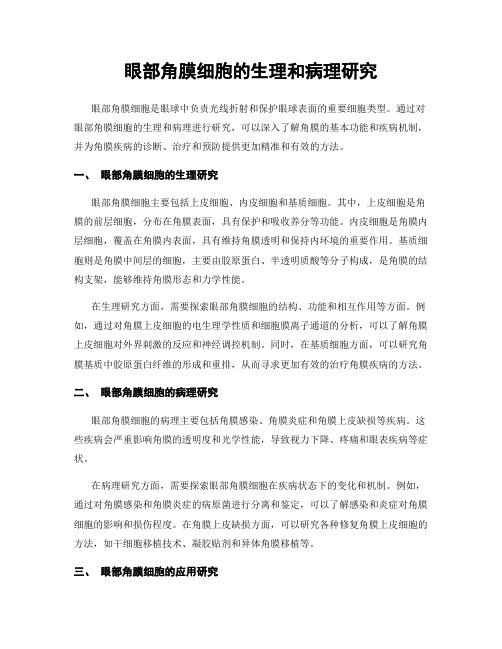
眼部角膜细胞的生理和病理研究眼部角膜细胞是眼球中负责光线折射和保护眼球表面的重要细胞类型。
通过对眼部角膜细胞的生理和病理进行研究,可以深入了解角膜的基本功能和疾病机制,并为角膜疾病的诊断、治疗和预防提供更加精准和有效的方法。
一、眼部角膜细胞的生理研究眼部角膜细胞主要包括上皮细胞、内皮细胞和基质细胞。
其中,上皮细胞是角膜的前层细胞,分布在角膜表面,具有保护和吸收养分等功能。
内皮细胞是角膜内层细胞,覆盖在角膜内表面,具有维持角膜透明和保持内环境的重要作用。
基质细胞则是角膜中间层的细胞,主要由胶原蛋白、半透明质酸等分子构成,是角膜的结构支架,能够维持角膜形态和力学性能。
在生理研究方面,需要探索眼部角膜细胞的结构、功能和相互作用等方面。
例如,通过对角膜上皮细胞的电生理学性质和细胞膜离子通道的分析,可以了解角膜上皮细胞对外界刺激的反应和神经调控机制。
同时,在基质细胞方面,可以研究角膜基质中胶原蛋白纤维的形成和重排,从而寻求更加有效的治疗角膜疾病的方法。
二、眼部角膜细胞的病理研究眼部角膜细胞的病理主要包括角膜感染、角膜炎症和角膜上皮缺损等疾病。
这些疾病会严重影响角膜的透明度和光学性能,导致视力下降、疼痛和眼表疾病等症状。
在病理研究方面,需要探索眼部角膜细胞在疾病状态下的变化和机制。
例如,通过对角膜感染和角膜炎症的病原菌进行分离和鉴定,可以了解感染和炎症对角膜细胞的影响和损伤程度。
在角膜上皮缺损方面,可以研究各种修复角膜上皮细胞的方法,如干细胞移植技术、凝胶贴剂和异体角膜移植等。
三、眼部角膜细胞的应用研究眼部角膜细胞的研究不仅可以深入了解角膜的生理和病理,还可以为角膜疾病的诊断、治疗和预防提供更加有效的方法。
在应用研究方面,可以利用眼部角膜细胞开发出各种治疗角膜疾病的方法。
例如,利用角膜基质细胞构建纤维蛋白板,可以替代传统的人工角膜,实现角膜缺损的修复。
同时,还可以利用角膜上皮干细胞技术,开发出更加精准和高效的治疗眼表疾病的方法。
干细胞在眼科临床和基础研究中的相关进展

干细胞在眼科临床和基础研究中的相关进展发表时间:2019-01-21T10:51:06.640Z 来源:《大众医学》2018年11月作者:王新乔[导读] 干细胞是一种多潜能细胞,其特性是具有定向分化与增殖的能力,如果机体内环境发生变化时,干细胞的分化潜能可以被体内不同信号途径所激活并定向分化为不同细胞和组织,因此干细胞有万能细胞之称。
摘要:干细胞是一种多潜能细胞,其特性是具有定向分化与增殖的能力,如果机体内环境发生变化时,干细胞的分化潜能可以被体内不同信号途径所激活并定向分化为不同细胞和组织,因此干细胞有万能细胞之称。
在眼科领域,干细胞为眼内功能障碍细胞的修复再生带来了希望,对角膜瘢痕、非新生血管性黄斑变性、色素性视网膜炎及斯特格氏病具有一定的治疗价值。
关键词:干细胞;眼科临床;基础研究;相关进展、1眼科研究中涉及的相关干细胞研究1.1角膜缘干细胞角膜缘干细胞的主要存在场所为角膜缘基地细胞,与角膜上皮更新有着紧密的联系。
相关学者通过对角膜缘干细胞的研究后发现,其所具备的“V ogt”栅栏结构特性主要存在与角膜基底部并与其关系密切。
干细胞不但可以增殖、分化为常丕细胞还可以形成一道屏障,用来阻滞结膜上皮细胞的移动并可以组个结膜上皮细胞进入到角膜表面,确保角膜可以有正常的功能与透明性。
当角膜出现白斑、溃疡或是化学烧伤等疾病时可以降低角膜缘干细胞的数量。
在眼科临床治疗中单眼疾病的患者可以通过角膜缘干细胞实现移植治疗;而双眼疾病的患者可以利用亲属干细胞进行角膜缘干细胞的移植。
1.2结膜干细胞结膜干细胞移植的主要位置为结膜上窟窿部位,利用组织培养可以实现结膜干细胞的扩增,当羊膜载体扩增到一定程度是时可以治疗结膜滤过泡渗漏。
1.3小梁网干细胞在猴子的Schwalbe利用小梁网干细胞可知,其可与角膜内皮细胞相连接,角膜内皮细胞密度要低于中央角膜细胞。
在进行青光眼患者治疗时可以使用小梁网干细胞移植方式,可有效的改善防水外流的情况。
眼表,

徐州医科大学附属淮安医院 眼科教研室 周 林
第一节 概 述
• 眼表(ocular surface):指始于上、
下眼睑缘灰线之间的眼球表面全部的黏膜 上皮,包括角膜上皮和结膜上皮。
• • • •
一,眼睑 二,泪液和泪膜 三,角膜上皮及其干细胞 四,结膜上皮
泪膜的构造
传统观念: 三层:脂质层 浆液层 粘蛋白层
– –
该染色法局部刺激性很强,临床难以推广应用 丽丝胺绿:细胞毒性低、无刺激,主要用于检查结膜上皮
泪河弯曲面 ( tear meniscus )
泪河弯曲面的曲率半径
☆正常(R1)>干眼症(R2) 正常为>0.5~1.0mm ☆ 0.35 mm是诊断为干眼 ☆该方法为非侵袭性检查,应用 方便,特异性强
干眼的诊断检查程序
• • • • • • • 问诊(自觉症状、患者背景:VDT、CL、LASIK 功能性视力(睁开眼注视10~20秒检查) 观查瞬目状态(瞬目频率、眼脸闭合状态) 检查泪河线高度 观察泪膜中有无过多的碎屑和黏液 裂隙灯 B U T 检查 检查 荧光素染色检查眼表上皮有无损害 • Schirmer试验(在所有非侵袭检查后进行)
眼表疾病分类
• 病理性的非角化上皮向角化型化生,称为 鳞状上皮化生(squamous metalasia) • 眼表功能异常是以正常角膜上皮被结膜上 皮侵犯和替代为特征,即角膜缘干细胞缺 乏(limbal stem cells deficiecy) • 泪膜异常
眼表疾病的治疗原则
• • • • •
泪液的组成
• 脂质层:睑板腺 • 水层:主、副泪腺 • 粘液层:结膜杯状细胞
• 正常泪液基础分泌量:1.2µl/min。 • 泪液pH值范围:5.20~8.35,平均7.35 • 泪液渗透压:295~309mOsm/L
眼科学——眼表疾病分析
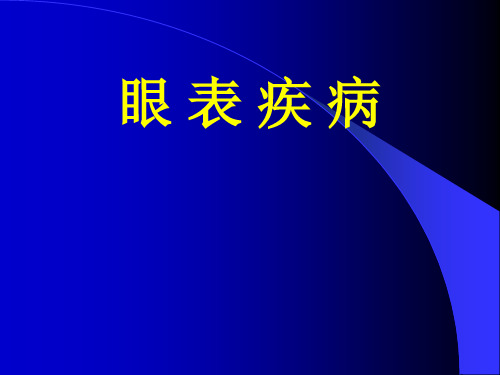
二、干 眼 症 定义:又称角结膜干燥症,指各种原 因引起的泪液质和量或动力学的异 常,导致泪膜不稳定和眼表组织病 变,并伴有眼部不适症状为特征的 一类疾病的总称。
分类: 1. 泪液生成不足型(即水样液缺乏性干眼症) 2. 蒸发过强型(包括睑板腺功能障碍、暴露、角 膜接触镜所致干眼症) 临床表现: 干涩、异物感、烧灼感、痒、畏光、视物模糊、 易视疲劳
眼表疾病
一、概述
1.眼表定义: 指上下睑缘灰线之间的眼球表面全部的粘膜 上皮。包括:角膜上皮、角膜缘上皮和结 膜上皮。广义上还包括:外眼附属器(眼 睑、泪器、泪道)。 2.功能:保证睁眼状态下的清晰视觉。 3.眼表疾病 狭义角、结膜上皮的疾病 广义包括角膜、结膜浅层疾病和可导致泪膜 功能异常的疾病。
诊断:根据以下四方面: 1.症状 2.泪液分泌量不足和泪膜不稳定 3.眼表面上皮细胞的损害 4.泪液的渗透压增加 注意: 引起干眼的原发病诊断也应明确,如:类 风湿性关节炎、系统性红斑狼疮、血管炎、 系统性硬化等。
干眼症的治疗 水样液缺乏性 ⑴消除诱因 ⑵泪液替代疗法 ⑶保留泪液戴硅胶眼罩、湿房镜、潜水镜
泪膜:从外到内由(三层) 脂质层由睑板腺分泌,阻止泪液蒸发 水液层由泪腺和副泪腺分泌,含蛋白、酶类、细
胞因子等
粘蛋白层由结膜杯状细胞分泌,降低表面
张力
泪膜的功能
①润滑及保护角膜和结膜上皮 ②填补上皮间不规则界面,保证角膜光滑 ③通过机械冲刷及抗菌成分的作用,抑制微生物生长 ④向角膜提供氧气及所需的营养物质 ⑤含有大量的蛋白质和细胞因子,调节角膜和结膜的多种细胞功能
胶原或硅胶泪小点栓子 手术封闭泪小点
⑷促进泪液分泌 ⑸手术腺体移植 ⑹其他
蒸发过强型 ⑴清洁眼睑:注意卫生、热敷、按摩 ⑵口服抗生素:四环素、多西环素 ⑶局部药物的应用:
眼科学主治医师-眼表疾病
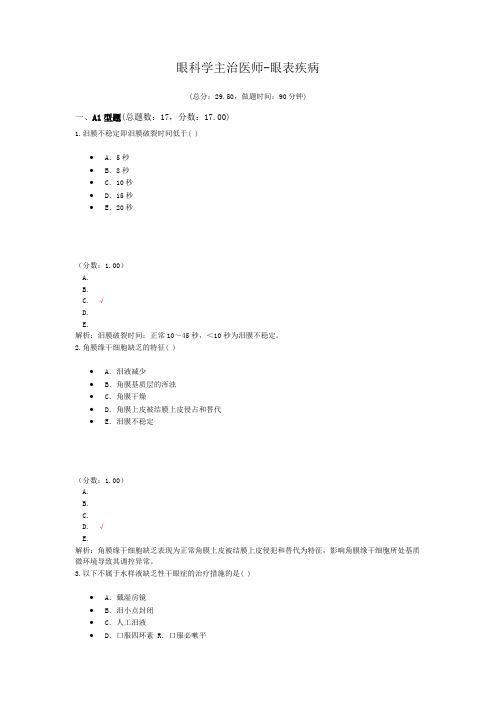
眼科学主治医师-眼表疾病(总分:29.50,做题时间:90分钟)一、A1型题(总题数:17,分数:17.00)1.泪膜不稳定即泪膜破裂时间低于( )∙A.5秒∙B.8秒∙C.10秒∙D.15秒∙E.20秒(分数:1.00)A.B.C. √D.E.解析:泪膜破裂时间:正常10~45秒,<10秒为泪膜不稳定。
2.角膜缘干细胞缺乏的特征( )∙A.泪液减少∙B.角膜基质层的浑浊∙C.角膜干燥∙D.角膜上皮被结膜上皮侵占和替代∙E.泪膜不稳定(分数:1.00)A.B.C.D. √E.解析:角膜缘干细胞缺乏表现为正常角膜上皮被结膜上皮侵犯和替代为特征,影响角膜缘干细胞所处基质微环境导致其调控异常。
3.以下不属于水样液缺乏性干眼症的治疗措施的是( )∙A.戴湿房镜∙B.泪小点封闭∙C.人工泪液∙D.口服四环素 R.口服必嗽平(分数:1.00)A.B.C.D. √E.解析:ATD的治疗措施包括①泪液成分替代治疗:人工泪液;②延迟泪液在眼表的停留时间:配戴硅胶眼罩、湿房镜或潜水镜;永久性泪小点激光、热烧灼手术切除等封闭术。
③促进泪液分泌:口服溴己新(必嗽平)等药物可促进部分患者泪液分泌。
4.降低泪膜表面张力的是( )∙A.脂质层∙B.黏蛋白层∙C.水液层∙D.细胞因子∙E.营养因子(分数:1.00)A.B. √C.D.E.解析:黏蛋白层基底部分嵌入角结膜上皮细胞的微绒毛之间,降低表面张力,使疏水的上皮细胞变为亲水。
5.泪液分泌试验低分泌为低于( )∙A.5min 10mm∙B.5min 8mm∙C.5min 5mm∙D.3min 8mm∙E.8min 10mm(分数:1.00)A. √B.C.D.E.解析:泪液分泌试验正常:10~15mm,<10mm为低分泌,<5mm为干眼,观察时间5分钟。
6.泪膜的主要功能不包括( )∙A.提供光滑的光学面∙B.湿润及保护角、结膜上皮∙C.抑制微生物生长∙D.向角膜提供营养物质∙E.上述均不正确(分数:1.00)A.B.C.D.E. √解析:7.关于干眼症的病因,下列哪项是错误的( )∙A.更年期妇女体内性激素水平改变∙B.眼睑位置异常∙C.长期长时间使用电脑∙D.维生素A缺乏∙E.神经支配异常(分数:1.00)A.B.C.D. √E.解析:干眼的病因:眼表面的改变、基于免疫的炎症反应、细胞凋亡、性激素水平的改变是干眼发生发展的相关因素。
(最新整理)第九章眼表疾病分析

2021/7/26
30
第三节 干 眼
2021/7/30
2021/7/26
31
31
干眼(dry eye)概念
❖ 角结膜干燥症又称为干眼,是指各种原因引起 的泪液质和量或动力学的异常导致的泪膜稳定 性下降,并伴有眼部不适和(或)眼表组织病 变特征的多种疾病的总称。
2021/7/30
2021/7/26
Ø 三叉神经的眼支(传入弧)——面神经(传出弧) Ø 眼睑的保护性反射很重要,眼表重建和角膜移植术前必
须先行眼睑重建。
2021/7/26
7
(二)泪液和泪膜
1、泪液一般性状
❖ 泪液为弱碱性透明液体 ❖ 水占98.2% ❖ 除含有少量蛋白和无机盐外,尚含有溶菌酶、免
疫球蛋白A(IgA),补体系统,β溶素和乳铁蛋白 ❖ 正常情况下为
2021/7/30
2021/7/26
27
27
三、眼表疾病的临床表现
❖ 角膜上皮结膜化 ❖ 角膜表面或深层新生血管 ❖ 角膜上皮糜烂,持续性角膜溃疡 ❖ 眼表面干燥 ❖ 假性翼状胬肉形成 ❖ 常有眼红、干涩、异物感、畏光、视力下降等
2021/7/30
2021/7/26
28
28
四、眼表疾病的治疗原则
9
2. 泪膜的组成:泪膜由外向内分3层—
❖粘蛋白层:含多糖蛋白,结膜杯状细胞分 泌,研究显示角膜上皮和结膜上皮至少可分 泌3种蛋白,降低表面张力均匀涂布于眼表, 维持眼表湿润。
2021/7/26
10
3.泪膜功能:
❖ ① 湿润及保护角膜和结膜上皮; ❖ ② 填补上皮间的不规则界面,保证角膜
的光滑; ❖ ③ 通过机械冲刷及内含的抗菌成分的作用
眼表疾病(知识讲座)
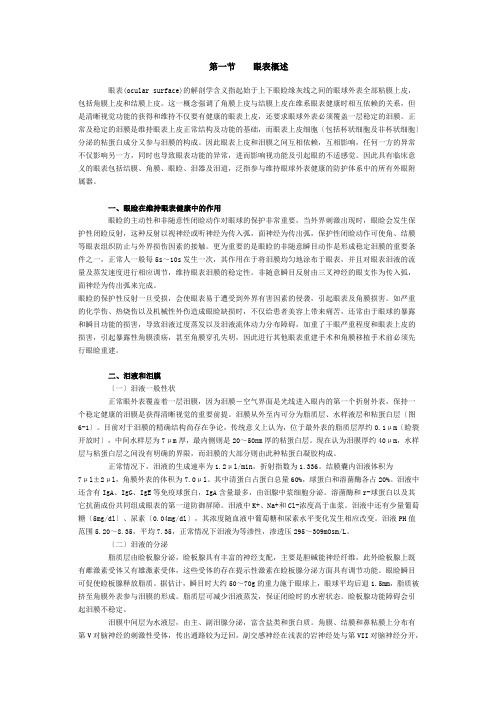
第一节眼表概述眼表(ocular surface)的解剖学含义指起始于上下眼睑缘灰线之间的眼球外表全部粘膜上皮,包括角膜上皮和结膜上皮。
这一概念强调了角膜上皮与结膜上皮在维系眼表健康时相互依赖的关系,但是清晰视觉功能的获得和维持不仅要有健康的眼表上皮,还要求眼球外表必须覆盖一层稳定的泪膜。
正常及稳定的泪膜是维持眼表上皮正常结构及功能的基础,而眼表上皮细胞〔包括杯状细胞及非杯状细胞〕分泌的粘蛋白成分又参与泪膜的构成。
因此眼表上皮和泪膜之间互相依赖,互相影响,任何一方的异常不仅影响另一方,同时也导致眼表功能的异常,进而影响视功能及引起眼的不适感觉。
因此具有临床意义的眼表包括结膜、角膜、眼睑、泪器及泪道,泛指参与维持眼球外表健康的防护体系中的所有外眼附属器。
一、眼睑在维持眼表健康中的作用眼睑的主动性和非随意性闭睑动作对眼球的保护非常重要,当外界刺激出现时,眼睑会发生保护性闭睑反射,这种反射以视神经或听神经为传入弧,面神经为传出弧,保护性闭睑动作可使角、结膜等眼表组织防止与外界损伤因素的接触。
更为重要的是眼睑的非随意瞬目动作是形成稳定泪膜的重要条件之一,正常人一般每5s~10s发生一次,其作用在于将泪膜均匀地涂布于眼表,并且对眼表泪液的流量及蒸发速度进行相应调节,维持眼表泪膜的稳定性。
非随意瞬目反射由三叉神经的眼支作为传入弧,面神经为传出弧来完成。
眼睑的保护性反射一旦受损,会使眼表易于遭受到外界有害因素的侵袭,引起眼表及角膜损害。
如严重的化学伤、热烧伤以及机械性外伤造成眼睑缺损时,不仅给患者美容上带来痛苦,还常由于眼球的暴露和瞬目功能的损害,导致泪液过度蒸发以及泪液流体动力分布障碍,加重了干眼严重程度和眼表上皮的损害,引起暴露性角膜溃疡,甚至角膜穿孔失明,因此进行其他眼表重建手术和角膜移植手术前必须先行眼睑重建。
二、泪液和泪膜〔一〕泪液一般性状正常眼外表覆盖着一层泪膜,因为泪膜-空气界面是光线进入眼内的第一个折射外表,保持一个稳定健康的泪膜是获得清晰视觉的重要前提。
- 1、下载文档前请自行甄别文档内容的完整性,平台不提供额外的编辑、内容补充、找答案等附加服务。
- 2、"仅部分预览"的文档,不可在线预览部分如存在完整性等问题,可反馈申请退款(可完整预览的文档不适用该条件!)。
- 3、如文档侵犯您的权益,请联系客服反馈,我们会尽快为您处理(人工客服工作时间:9:00-18:30)。
Hans Journal of Ophthalmology 眼科学, 2019, 8(4), 127-133Published Online December 2019 in Hans. /journal/hjohttps:///10.12677/hjo.2019.84021The Function and Localization of CornealEpithelial Stem Cells and Its Relationshipwith Ocular Surface DiseasesJunhua FanDepartment of Ophthalmology of the 910th Hospital of PLA, Quanzhou FujianReceived: Nov. 9th, 2019; accepted: Nov. 27th, 2019; published: Dec. 4th, 2019AbstractCorneal epithelial stem cells (CESCs) play an important role in repairing corneal epithelium. Their localization in limbus corneae has been widely recognized. However, more and more studies show that no matter through specific markers or functional localization, it cannot be confirmed that corneal epithelial stem cells are located only in limbus, and limbus stem cells play a limited role in renewal and repair of corneal epithelial. This article reviews the different viewpoints and evi-dences of corneal epithelial stem cells research, and summarizes the recent studies about the function and the localization of corneal epithelial stem cells and the relationship with ocular sur-face diseases in recent years.KeywordsCorneal Epithelial Stem Cells, Limbal Stem Cells, Ocular Surface Diseases,Limbal Stem Cell Deficiency角膜上皮干细胞的功能定位及其与眼表疾病的关系范军华解放军第910医院眼科中心,福建泉州收稿日期:2019年11月9日;录用日期:2019年11月27日;发布日期:2019年12月4日范军华摘要角膜上皮干细胞具有更新修复角膜上皮的重要功能,其定位于角膜缘受到广泛认可,但有越来越多的研究表明,不管是通过特异性标识物定位还是功能定位,都无法证实角膜上皮干细胞仅位于角膜缘,角膜缘干细胞在角膜上皮更新修复方面起到的作用有限。
本文通过对角膜上皮干细胞研究的不同观点和证据的阐述,对近年来有关角膜上皮干细胞的功能定位及其与眼表疾病的关系研究作一综述。
关键词角膜上皮干细胞,角膜缘干细胞,眼表疾病,角膜缘干细胞功能障碍Copyright © 2019 by author(s) and Hans Publishers Inc. This work is licensed under the Creative Commons Attribution International License (CC BY). /licenses/by/4.0/1. 引言1971年Davanger 首次提出角膜缘干细胞的概念,认为角膜缘部位存在干细胞,可发挥上皮细胞更新及损伤修复的作用,是维持角膜透明无血管的重要原因。
随着对角膜缘干细胞功能的认识加深,临床上通常将各种原因导致的眼表疾病的终末阶段统称为角膜缘干细胞功能障碍(Limbal Stem Cell Deficiency, LSCD) [1],认为其发病机制是角膜缘上皮基底层的干细胞缺失或受损所引起。
但是,近年来有研究认为,角膜上皮干细胞并非只存在于角膜缘部位,整个角膜上皮基底层均存在寡能干细胞(Oligopotent Stem Cells, OSCs),它们可能也是角膜上皮更新的重要细胞来源,而角膜缘干细胞在角膜上皮更新和角膜稳态维持方面并未发挥关键作用。
本文结合近年来对角膜上皮干细胞的新认识和研究结果,对其功能及与LSCD 的关系作一综述。
2. 角膜缘干细胞的标识与定位2.1. 角膜上皮干细胞的概念干细胞是一类未充分分化、具有自我复制能力的多潜能细胞,在一定条件下,它可以分化成多种功能细胞。
根据干细胞所处的发育阶段分为胚胎干细胞和成体干细胞[2]。
根据干细胞的发育潜能分为三类:全能干细胞、多能干细胞、单能干细胞。
角膜上皮干细胞属于成体干细胞中的单能干细胞,发育等级较低,一般仅能向角膜上皮细胞分发。
角膜上皮干细胞历经干细胞、短暂扩增细胞(Transient Amplifying Cells, TACs)和终末分化细胞(Terminally Differentiated Cells, TDCs) 3个分化阶段而构成不断更新的角膜上皮组织。
1986年,Schermer 等[3]通过研究指出,角膜缘干细胞位于约1.5 mm 的角膜缘环形区域内上皮细胞基底层的Vogt 栅栏内。
角膜上皮干细胞因长期被定位于角膜缘上皮的基底层而又称为角膜缘干细胞(Limbal Stem Cells, LSCs)。
2.2. 角膜缘干细胞的物理定位与标识自Davanger 首次提出角膜缘干细胞的概念以来,寻找角膜缘干细胞特异性标记物的研究从未中断,但始终未找到一种或一组能直接确定角膜缘干细胞的绝对特异性标记物。
在寻找角膜上皮干细胞标志物范军华的各种研究中,主要的依据和方法有:(1) 定位依据。
根据角膜上皮干细胞仅位于角膜缘基底层的判断,寻找仅表达于角膜缘上皮基底层细胞的标记物,认为这些标记物就是角膜缘干细胞特异性标记物。
由于这个判断本身需要通过特异性标记物来证实,以此作为寻找角膜缘干细胞的依据,缺乏严谨性。
既使如此,最新研究表明,过去认为仅表达于角膜缘的LSCs的特异性标记物在中央角膜也有所表达[4][5][6],只是表达量的多少存在差异,特异性标记物并不特异,以仅表达于角膜缘上皮基底层的分子作为LSCs 标记物的传统观点需要修正。
Lyngholm等[7]用二维聚乙烯酰胺凝胶电泳联合质谱法分析眼表上皮细胞中多种蛋白的表达,发现在角膜缘和角膜中央上皮表达水平有明显差异的蛋白多达25种,这些标记物的差异只能说明角膜缘上皮基底细胞与角膜中央上皮细胞有所不同,但无法证明角膜缘上皮基底细胞就是干细胞。
(2) 表达共识表记物。
将表达于人类其它干细胞的共识标记物作为角膜缘干细胞标记物。
常见的共识标记物有原始干细胞转运蛋白家族ABCG2、ABCB5、转录因子p63、类鸟苷酸结合蛋白3、TCF4、细胞黏附分子integrinβ1、Bmi-l等[5][6][8],体外角膜基底细胞培养表明这些标记物主要表达于角膜缘基底层,但也可部分表达于中央角膜的基底层和基底上层,依据共识标记物,还不能认定角膜上皮干细胞仅位于角膜缘上皮基底部。
(3) 具有干细胞的某些形态和功能特点。
角膜缘上皮基底层细胞具有干细胞的某些形态和功能特点,比如角膜缘上皮基底部细胞与角膜中央上皮基底层细胞不同,体积更小,内含色素;角膜缘的肿瘤发病率高于角膜中央区,结合肿瘤更易发生于低分化、增殖能力强的细胞这一特点,提示角膜上皮干细胞可能存在于角膜缘;角膜缘上皮细胞部分或全部缺损后,角膜出现结膜化、新生血管等,这种情况可以通过LSCs移植得到改善。
角膜缘上皮基底层细胞的这些形态和功能特点提示角膜缘可能是角膜上皮干细胞的主要存在部位,但并不能作为角膜缘基底细胞是干细胞的直接证明,也不能据此排除角膜其它部位存在干细胞的可能性。
因为,人体组织细胞的增殖分化都是由所处的微环境诱导的,角膜缘与角膜中央区微环境明显不同,两处的上皮细胞在形态和功能上自然会存在差异,不能将这种差异完全归于普通细胞与干细胞之间的差异。
此外,人体组织的增殖和愈合能力与血供营养有关,角膜缘血管网丰富,增殖愈合能力强于中央角膜,因此,角膜中央上皮受损通常由角膜缘上皮修复,这与干细胞是否存在角膜缘可能无关。
总之,现在发现的各种LSCs标记物并无绝对的特异性,无法通过现有LSCs标记物鉴定角膜上皮干细胞。
各种LSCs标识物研究表明,角膜缘基底层的上皮细胞与角膜其它区域的上皮细胞存在明显差异,角膜缘基底层是角膜上皮干细胞可能的储存部位,但不能排除角膜其它区域也存在角膜上皮干细胞的可能性。
2.3. 角膜缘干细胞的功能定位与作用角膜上皮干细胞的主要功能是能更新修复角膜上皮,保持角膜上皮的完整性。
完整的角膜上皮可使角膜免受外界物理或化学损伤,阻碍病原微生物侵袭损伤,抑制免疫炎症及角膜新生血管形成,从而维持眼表的稳定。
虽然无法通过角膜干细胞标识物对角膜上皮干细胞进行物理定位,但如果能证明只有角膜缘基底细胞才具有角膜上皮干细胞的功能,那么就能确定角膜上皮干细胞只位于角膜缘,从而在功能上实现对角膜上皮干细胞的定位。
角膜上皮干细胞的功能定位研究主要围绕两方面进行:一方面研究,在仅仅去除角膜缘上皮细胞的情况下,是否可以造成持续性角膜上皮结膜化、角膜新生血管形成、角膜炎症和溃疡等典型的LSCD表现;另一方面研究,对于LSCD病变,是否只能通过角膜缘干细胞移植来治愈,移植角膜中央上皮、结膜上皮或其它组织治疗均无效。
对于第一方面,刘先宁等[9]通过两种方法构建LSCD动物模型,I组10只实验兔去除角膜缘内外2 mm以内的上皮及浅基质层组织;II组10只实验兔在I组基础上同时清除角膜中央上皮及浅基质层组织。
结果发现I组有6只兔子在平均7 d的时间点角膜完全自愈,角膜维持透明并无新生血管形成,构建LSCD模型失败;II组10只实验兔均符合LSCD范军华标准,成功率100%。
由此表明,仅仅去除角膜缘上皮及基质层,并不能造成LSCD模型,只有连同角膜中央上皮及基质层去除的情况下,才能造成LSCD模型,提示角膜中央上皮也具有增殖修复能力, 表明在角膜中央区也可能存在角膜上皮干细胞。
